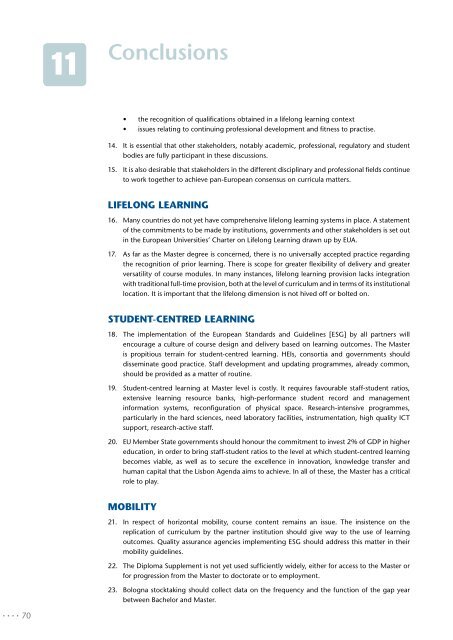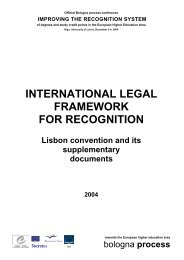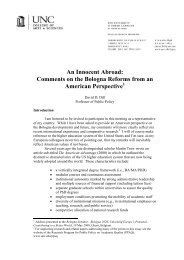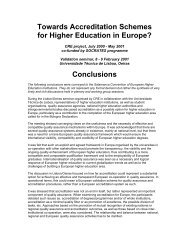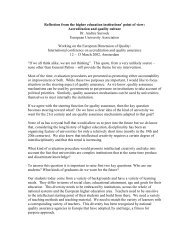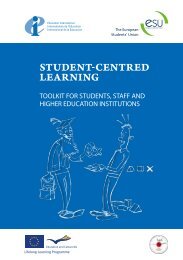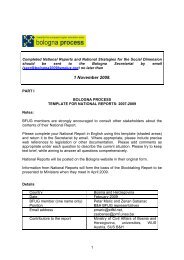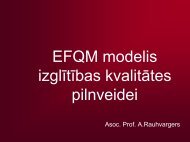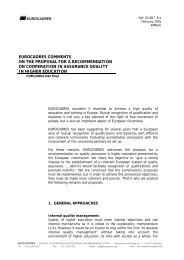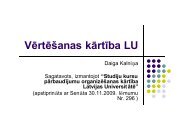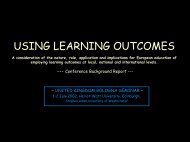EUA Survey Of Master Degrees In Europe - European University ...
EUA Survey Of Master Degrees In Europe - European University ...
EUA Survey Of Master Degrees In Europe - European University ...
You also want an ePaper? Increase the reach of your titles
YUMPU automatically turns print PDFs into web optimized ePapers that Google loves.
11Conclusions• the recognition of qualifications obtained in a lifelong learning context• issues relating to continuing professional development and fitness to practise.14. It is essential that other stakeholders, notably academic, professional, regulatory and studentbodies are fully participant in these discussions.15. It is also desirable that stakeholders in the different disciplinary and professional fields continueto work together to achieve pan-<strong>Europe</strong>an consensus on curricula matters.Lifelong learning16. Many countries do not yet have comprehensive lifelong learning systems in place. A statementof the commitments to be made by institutions, governments and other stakeholders is set outin the <strong>Europe</strong>an Universities’ Charter on Lifelong Learning drawn up by <strong>EUA</strong>.17. As far as the <strong>Master</strong> degree is concerned, there is no universally accepted practice regardingthe recognition of prior learning. There is scope for greater flexibility of delivery and greaterversatility of course modules. <strong>In</strong> many instances, lifelong learning provision lacks integrationwith traditional full-time provision, both at the level of curriculum and in terms of its institutionallocation. It is important that the lifelong dimension is not hived off or bolted on.Student-centred learning18. The implementation of the <strong>Europe</strong>an Standards and Guidelines [ESG] by all partners willencourage a culture of course design and delivery based on learning outcomes. The <strong>Master</strong>is propitious terrain for student-centred learning. HEIs, consortia and governments shoulddisseminate good practice. Staff development and updating programmes, already common,should be provided as a matter of routine.19. Student-centred learning at <strong>Master</strong> level is costly. It requires favourable staff-student ratios,extensive learning resource banks, high-performance student record and managementinformation systems, reconfiguration of physical space. Research-intensive programmes,particularly in the hard sciences, need laboratory facilities, instrumentation, high quality ICTsupport, research-active staff.20. EU Member State governments should honour the commitment to invest 2% of GDP in highereducation, in order to bring staff-student ratios to the level at which student-centred learningbecomes viable, as well as to secure the excellence in innovation, knowledge transfer andhuman capital that the Lisbon Agenda aims to achieve. <strong>In</strong> all of these, the <strong>Master</strong> has a criticalrole to play.Mobility21. <strong>In</strong> respect of horizontal mobility, course content remains an issue. The insistence on thereplication of curriculum by the partner institution should give way to the use of learningoutcomes. Quality assurance agencies implementing ESG should address this matter in theirmobility guidelines.22. The Diploma Supplement is not yet used sufficiently widely, either for access to the <strong>Master</strong> orfor progression from the <strong>Master</strong> to doctorate or to employment.23. Bologna stocktaking should collect data on the frequency and the function of the gap yearbetween Bachelor and <strong>Master</strong>.70


